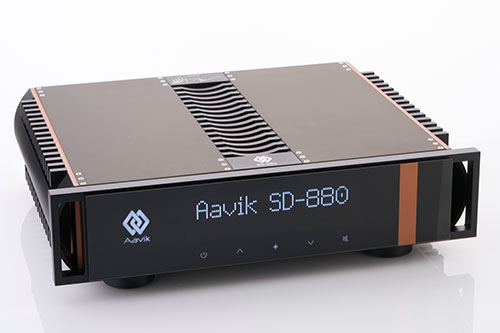Below the gold-plated speaker terminals provenient from specialist WBT, located in the German city of Essen, the integrated power amplifier section can be directly adressed. Next to it, as a counterpart, a pre-amplifier output is to be found. Electrically, this input terminal is on par with the other high-level inputs. Compared to the numerous RCA sockets, the two additional balanced XLR sockets rather stick out visually. My query to the extremely friendly team at Struss Audio, whether this type of contact is preferred, was answered in an undogmatical way: "That depends on the whole set-up. It’s not clear from the outset what will work out better in the end". Whilst not wishing to anticipate what comes later on, I must say that within the environment of the test system this type of input convinced with a somewhat more catchy, more stable performance. However, a headphone output isn’t to be found here at all. But, according to the Polish headquarters, an independent customized solution to feed any type of head-fitting transducers is going to be launched in the course of the year.

On the contrary, there is a remote control and it shows up as a real eye-catcher. It’s round and rests rock-solid on any surface due to its own weight, while accommodating exactly two single keys: Volume up and volume down. That appears to be stingy, but is part of the sound-optimised concept. Within the Ultimate, Struss Audio completely dispenses with any amplification in the pre-amplifier section. Incoming high level signals are thus treated solely in a passive manner. This significantly reduces the number of potentially sound-impairing components in the signal path. And so the Spartanic furnished remote control fits well into the overall picture as well.

Since features like source switching via remote control are not offered, the corresponding circuits on the board layout are obsolete. It’s conceptionally not very surprising that there is no balance control or the possibility to equalize the sound. The overall minimalism is reflected in a nice looking, clearly structured front panel. The visually dominant volume control, which operates with excellent channel synchronisation, uses a red LED to indicate the adjusted level. The engine bay presents itself accordingly tidy and cleaned up. The distances are short and the meticulously built discrete phono section is located sufficiently far away from the two transformers, which themselves are positioned directly adjacent to the power amplifier channels.
-
Aavik SD-880 Streamer/DAC
Endlich ist es soweit und ich kann Ihnen den Streaming-DAC SD-880 von Aavik vorstellen. Eigentlich war geplant, den Bericht zeitnah im Anschluss an Dirk Sommers Beschäftigung mit der Vorstufe C-800 und dem Endverstärker P-880 zu bringen, aber es hat dann doch länger gedauert, bis ein Gerät seinen Weg zu uns fand. Das Schöne für einen Autor bei Hifistatement ist, dass man regelmäßig Zugang zu absoluten Spitzenkomponenten bekommt, die ohne Kompromisse bei Qualität und Preis den…01.04.2025 -
Lumin T3X
Der neue Lumin T3X Netzwerkplayer ist das Nachfolgemodell des hochgelobten Lumin T3 Netzwerkplayers und wartet mit einem neuen linearen Netzteil mit Ringkerntransformator und der Möglichkeit einer optischen Netzwerkverbindung auf. Der LUMIN T3X High-End-Netzwerkstreamer besitzt ein massives Aluminiumgehäuse, das die internen Komponenten vor mechanischen Vibrationen und elektromagnetischen Störungen schützt. Das neu entwickelte lineare Netzteil beinhaltet einen speziell gewickelten, großzügig dimensionierten Ringkerntransfo. Das Netzteil ist durch ein extra Metallgehäuse von den übrigen elektronischen Komponenten getrennt, hierdurch sollen…28.03.2025 -
iFi iDSD Valkyrie
iFi hat sich bei mir einen Ruf als Hersteller überdurchschnittlich vielseitiger, durchentwickelter Produkte zu überaus fairen Preisen erarbeitet. Mit dem iDSD Valkyrie bespielt iFi die recht neue Sparte von semi-portablem HiFi, das auch stationär anderen Schreibtisch-Lösungen in nichts nachstehen soll. Mythologische Beinamen wurden mit dem xDSD Gryphon in iFis Produktlinie eingeführt. Der iDSD Valkyrie setzt diese Tradition fort und trägt dabei einen Namen aus der nordischen Mythologie. Das Design des iDSD Valkyrie ist von Flügeln…25.03.2025 -
Silversmith Audium Fidelium RCA
Nach der uneingeschränkt positiven Erfahrung mit dem Silversmith Audio Fidelium Lautsprecherkabel vor einigen Monaten konnte ich nicht anders, als das Testkabel zu erwerben. Die Investition habe ich keine Sekunde bereut. Schon damals wurden auf der Silversmith Audio Website weitere Kabel angekündigt. Auf die war ich selbstverständlich extrem neugierig. Überraschend schnell bot mir vor einigen Wochen Davide Della Casa als Importeur Hifi4music einen frisch eingetroffen Satz Cinch-Kabel zum Test, dem ersten in Europa. Zwar hätte ich…21.03.2025 -
Andante Largo Silent Mount SM-7FX und Super Trans Music Device
Kürzlich berichtete ich an dieser Stelle über den Besuch von Suzuki san, dem Kopf von Andante Largo, in Gröbenzell, konnte aber nur die kurzen Erfahrungen mit dem fantastischen Rack beschreiben. Jetzt steht im Hörraum eine Box mit Spikes, so dass ich die Spikes-Teller und zudem die Kontaktflüssigkeit von Andante Largo ausprobieren kann. In der Andante-Largo-Terminologie heißen die Untersetzer für Spikes „Silent Mounts“. Es werden fünf Versionen angeboten, und zwar mit Durchmessern von 35, 50 und…14.03.2025 -
Canor Virtus I2 Premium Line
Über den slowakischen Audio-Spezialisten Canor las und hörte ich bislang nur Gutes. Der Vollverstärker Virtus I2, ein Class-A-Röhrenvollverstärker ist das erste Gerät von Canor in meinem Hörraum. In mehrerlei Hinsicht hebt er sich ab von dem, was ich kenne. Das gilt nicht nur für seine Optik oder sein Innenleben, sondern besonders für seinen Klang. Armin Kern, der in Norddeutschland als Repräsentant für anspruchsvolle HiFi-Marken unterwegs und in der Branche als erfahrener Audio-Spezialist gern gesehen ist,…11.03.2025
© 2025 | HIFISTATEMENT | netmagazine | Alle Rechte vorbehalten | Impressum | Datenschutz





























 |
|
































































































